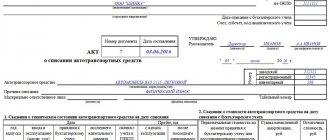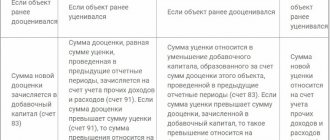Difference between new and used car
Depending on whether a car is purchased new or used, the act is drawn up by the accountant of the purchasing company or the seller of the car:
| New car | Used car |
| As usual, a dealer or showroom issues an invoice when selling a car, but does not deal with acceptance and transfer acts, so the responsibility falls on the buyer. | It makes sense to ask the seller to draw up the act. He will have to indicate in it information from the accounting system and data for calculating depreciation in the accounting system. This information includes:
You can accept UPD from the seller with the caveat that the data mentioned above will be indicated separately in the document. |
If you do not receive information about the useful life of a used car, all that remains is to accept it as equal to the useful life of a new vehicle, the values of which, of course, are not equal. This will significantly increase the company's costs and lead to incorrect calculations of depreciation and other indicators, and, as a result, to claims from tax inspectors.
The initial cost of the car consists of:
- the amount spent on the purchase of a car;
- expenses incurred during the purchase.
| ★ Best-selling book “Accounting from scratch” for dummies (understand how to do accounting in 72 hours) > 8,000 books purchased |
Costs related to purchasing a car
- State duty for traffic police services for car registration To avoid problems with the tax service, it is better to add the amount of the duty to the original cost of the car. The tax claims are related to the fact that money is written off over a long period of time, through depreciation expenses. In the case of a one-time attribution of expenses to other expenses, the company underestimates the income tax.
- Vehicle modernization. The tax inspectorate calls any addition to a car a modernization, since this will not change the characteristics and purpose of the car (and it doesn’t matter whether the car is new or used). There is an option for additional accounting. equipment costing more than 40 thousand rubles as an independent fixed asset. Or you can recognize an expense in the current period if the replenishment cost less than 40 thousand. However, designing a heater in this way can cause controversy because connecting it changes the characteristics of the car.
- Input VAT. VAT specified by the seller is also paid separately from the original cost. It is legal to take it into account as an expense under general conditions.
- Loan interest. In cases where the car was purchased with borrowed money, the overpayment on the loan is not included in the original cost. It is included in the lists of expenses as a percentage of any other debts, and the interest is necessarily normalized (the write-off occurs within the limits of the refinancing rate, multiplied by a coefficient of 1.8).
| ★ Best-selling book “Accounting from scratch” for dummies (understand how to do accounting in 72 hours) > 8,000 books purchased |
Repair costs
The purchase of vehicles (both new and used) is carried out under a sales contract. The initial cost is formed from the following elements: 1) the amount actually paid to the supplier (seller) under the agreement; 2) the amount of payment for consulting and information services related to the purchase of a vehicle;
3) state fees associated with the preparation of documents confirming the organization’s right to a vehicle. Such expenses include, for example, the fee for registering a car with the traffic police: for conducting a technical inspection, obtaining a vehicle registration certificate, vehicle passport, license plates;
4) customs duties and customs fees (paid if the vehicle is imported by the organization into the territory of Russia); 5) the amount of remuneration paid to the intermediary organization; 6) the actual costs of the organization for delivering the purchased vehicle and bringing it into a condition suitable for use;
7) other costs directly related to the acquisition of a motor vehicle. According to paragraph 8 of PBU 6/01, the actual costs of acquiring fixed assets do not include general and other similar expenses, except when they are directly related to the acquisition of fixed assets.
For example, a purchase and sale agreement may provide for the participation of a buyer’s representative in the shipment of cars from the manufacturer. The purchasing company sends the head of the technical department to the manufacturing plant. His travel expenses should be included in the initial cost of the vehicles received.
In accounting, information about the initial cost of a fixed asset is reflected in balance sheet account 08 “Investments in non-current assets”, subaccount 4 “Acquisition of fixed assets”. The generated initial cost of fixed assets accepted for operation and registered in the prescribed manner is written off to the debit of balance sheet account 01 “Fixed Assets”. EXAMPLE
| In March, ZAO Saturn purchased a truck worth 1,180,000 rubles, including VAT - 180,000 rubles, under a purchase and sale agreement. According to the terms of the contract, transportation costs for the delivery of the car are borne by the purchasing company. The car was delivered by rail. The railway tariff was 35,400 rubles, VAT on the railway tariff was 5,400 rubles. When registering a car with the traffic police, the company paid a state fee of 600 rubles. We will formulate the initial cost of the truck. It will include the following expenses incurred by Saturn CJSC: 1) payment to the supplier - 1,000,000 rubles; 2) railway tariff - 30,000 rubles; 3) state duty - 600 rubles; In total, the initial cost of the truck will be 1,030,600 rubles. On March 31, the car was put into operation as part of the fixed assets of Saturn CJSC. The accountant of Saturn CJSC will make the following entries in March: DEBIT 08-4 CREDIT 60 - 1,000,000 rubles. — the cost of the truck excluding VAT; DEBIT 19-1 “VAT on the acquisition of fixed assets” CREDIT 60 - 180,000 rubles. — VAT presented by the supplier of the truck; DEBIT 08-4 CREDIT 60 - 30,000 rub. — railway tariff; DEBIT 19-1 CREDIT 60 - 5400 rub. — VAT claimed by the railway; DEBIT 68 CREDIT 51 - 600 rub. — state duty is transferred; DEBIT 08-4 CREDIT 68 - 600 rub. — the amount of state duty is included in the cost of purchasing a car; DEBIT 01 CREDIT 08-4 - 1030600 - the initial cost of the truck after its commissioning is reflected in the accounting; DEBIT 68 CREDIT 19-1 - 180,000 rub. — tax deduction of VAT presented by the supplier. This deduction reduces the VAT to be transferred to the budget only after the truck has been accepted for accounting as part of fixed assets and in the presence of a supplier invoice; DEBIT 68 CREDIT 19-1 - 5400 rub. — tax deduction of VAT claimed by the railway. This deduction is also applied after the truck is accepted for accounting as part of fixed assets and if there is an invoice from the carrier organization; DEBIT 51 CREDIT 60 - 1,180,000 rub. — the invoice of the truck supplier has been paid; DEBIT 51 CREDIT 60 - 30,000 rub. — the railway tariff including VAT has been paid. |
According to the rules established by Articles 171 and 172 of the Tax Code of the Russian Federation, in order to claim for tax deduction the amount of value added tax paid upon the acquisition of motor vehicles, the following conditions must be met: - the motor vehicle is accepted for accounting on balance sheet account 01 “Fixed Assets”, which is confirmed relevant primary documents (invoice for receiving the car, certificate of acceptance and transfer of fixed assets form OS-1, order of the manager to put the vehicle into operation);
- the vehicle will be used in activities subject to VAT; - invoices presented by suppliers are available; - supplier invoices are registered in the purchase book. If the car is imported into the customs territory of Russia, then in order to obtain a VAT tax deduction, a document is also required confirming the actual payment of the tax amount.
If an organization applies a simplified taxation system, then VAT on purchased vehicles is not accepted as a tax deduction. Paragraph 8 of PBU 6/01 allows non-refundable taxes to be included in the initial cost of a fixed asset. Therefore, an organization that uses a simplified taxation system includes the amount of “input” VAT in the initial cost of a fixed asset. Let’s look at an example of how to reflect the purchase of a car in accounting in this case. EXAMPLE
| The LLC Sever enterprise uses a simplified taxation system. The company purchased a truck worth 236,000 rubles, including VAT of 36,000 rubles. When registering a car with the traffic police, Sever LLC paid a state duty in the amount of 600 rubles. The accountant of Sever LLC will make the following entries in the accounting: DEBIT 08-4 CREDIT 60 - 200,000 rubles. — the price of the car without VAT under the sales contract; DEBIT 19-1 CREDIT 60 - 36,000 rub. — VAT presented by the car supplier; DEBIT 08-4 CREDIT 19-1 - 36,000 rub. — the amount of VAT claimed by the supplier is reflected in the costs of acquiring fixed assets; DEBIT 68 CREDIT 51 - 600 rub. — the state fee for registering a car is transferred; DEBIT 08-4 CREDIT 68 - 600 rub. — the amount of state duty is reflected in the cost of acquiring fixed assets; DEBIT 01 CREDIT 08-4 - 236,600 rub. — the car was put into operation, its original cost is reflected; DEBIT 60 CREDIT 51 - 236,000 rub. — the invoice of the car supplier has been paid. |
The initial cost of a car is formed in a similar way for organizations that will use it for activities or operations not subject to VAT. For example, an organization bought a car exclusively for retail trade, for which a single tax on imputed income is paid.
The organization will include the “input” VAT in the initial cost of the car. If the organization intends to use the car for both VAT-taxable and non-VAT-taxable activities, the amount of the “input” VAT should be distributed between the initial cost of the car and the tax deduction. Let's consider the described situation using an example. EXAMPLE
| The organization carries out wholesale and retail trade. At the same time, in retail trade, the organization pays a single tax on imputed income. In May, the organization purchased a car for 354,000 rubles, including VAT of 54,000 rubles. In the same month, the organization put the car into operation. It is necessary to distribute the “input” VAT in proportion to the cost of goods shipped in the second quarter in wholesale and retail trade, that is, between types of activities subject to and exempt from VAT. Let's assume that in the second quarter the goods were shipped: in retail trade (UTII) - 500,000 rubles. (33.3%) in wholesale trade (general taxation regime) - 1,000,000 rubles. (66.7%) Total sales - 1,500,000 rubles. (100%) We will make accounting entries reflecting the formation of the initial cost of the car: DEBIT 08-4 CREDIT 60 - 300,000 rubles. — the price of the car without VAT under the sales contract; DEBIT 19-1 CREDIT 60 - 54,000 rub. — VAT presented by the car supplier; DEBIT 19-1/01 CREDIT 19-1 — 36018 rub. (54000x 66.7%) - the amount of VAT claimed by the supplier related to wholesale trade; DEBIT 19-1/02 CREDIT 19-1 — 17982 rub. (54000 x 33.3%) - the amount of VAT claimed by the supplier related to retail trade; DEBIT 08-4 CREDIT 19-1/02 - 17982 rub. — the amount of VAT claimed by the supplier is reflected in the costs of acquiring fixed assets; DEBIT 68 “VAT” CREDIT 19-1/01 - 36018 rub. — VAT tax deduction; DEBIT 01 CREDIT 08-4 — 317982 rub. (300000 17982) - the car was put into operation, its original cost is reflected; DEBIT 60 CREDIT 51 - 354,000 rub. — the invoice of the car supplier has been paid. |
If a vehicle was purchased for foreign currency, then its value is determined in rubles by recalculating the amount in foreign currency at the rate of the Central Bank of the Russian Federation on the date of recognition of the costs that form the cost of the fixed asset, that is, on the date of acceptance of the costs for accounting on balance sheet account 08. This provision is contained in PBU 3/2006 “Accounting for assets and liabilities, the value of which is expressed in foreign currency” (Order of the Ministry of Finance of Russia dated November 27, 2006 N 154n). EXAMPLE
| The organization purchased a car from a foreign partner for $10,000. According to the terms of the contract, ownership of the car passes to the buyer on the date of crossing the border. On May 10, the car crossed the border. The US dollar exchange rate set by the Bank of Russia on May 10 was 23.4 rubles/USD. An entry was made in the organization's accounting: DEBIT 08-4 CREDIT 60 - 234,000 rubles. (10,000 USD x 23.4 rubles/USD) - the price of the car in ruble equivalent on the date of crossing the border; DEBIT 08-4 CREDIT 76 - 20,000 rub. — customs duties and taxes are assessed; DEBIT 08-4 CREDIT 68 - 600 rub. — the state duty for registering the car has been charged. The car was put into operation on June 10. An entry was made in the organization's accounting: DEBIT 01 CREDIT 08-4 - 254,600 rubles. (234000 20000 600) - reflects the initial cost of the car on the date of commissioning. |
Useful life of the vehicle
During the SPI, it is legal to write off the original cost of the car. For new cars, the terms are standardized according to the established Classification of Fixed Assets:
Important! Try to choose the minimum specified SPI, this will help you write off the cost of buying a car in the shortest possible time.
Difficulties arise with the SPI of used cars, it is calculated using the formula:
- SPI used = SPI of a similar new car - the period of operation by the previous owner.
A used SPI is included in the same depreciation group as the previous owner had it. It is better to charge depreciation, even if you have less than a year left to use the car. When a car was purchased from an individual who is not engaged in business, SPI is determined as based on new fixed assets that appeared.
Calculation of depreciation on a purchased car
To correctly calculate depreciation, you need to have knowledge of two indicators:
- depreciation start date;
- SPI, during which the initial cost is written off.
| In accounting | In tax accounting |
| Depreciation begins on the first day of the month following the month the vehicle was registered as part of the operating system. To be clear, depreciation is calculated even for vehicles that are not used, if they are fit for use. | Depreciation is controlled from the first day of the month following the month when the car was actually used. Proof that this particular month was the month of start of use will be the date indicated in the act of putting the car into operation. |
An example of calculating a leasing agreement
The total amount of the leasing agreement is RUB 751,500.00, including VAT 20% - RUB 125,250.00. Initial payment (advance payment) - 150,000.00 rubles, including VAT 20% - 25,000.00 rubles. Leasing term - 2 years (24 months + the last month the redemption price is paid), redemption price - 1,500.00 rubles, including VAT 20% - 250 rubles. The monthly payment is (751,500.00 - 1,500 − 150,000.00) / 24 = 25,000.00 rubles, including 20% VAT - 4,166.67 rubles.
Read about what the redemption value of a leased asset is here..
It is worth noting that there is no single standard for a leasing agreement, so the advance payment can also be counted as the first monthly lease payment or towards several monthly lease payments. These conditions must be clearly stated in the leasing agreement.
See also “Car leasing agreement for legal entities”.
In the future, we will use the conditions from this example to describe accounting entries.
Rationing of fuels and lubricants
Previously, the Ministry of Finance proposed rationing fuel and lubricants for correct tax accounting, but at the moment the financial department has recognized this as a right of organizations, not an obligation, due to the absence of such requirements in the tax code. Based on the foregoing, an enterprise registered for tax purposes under a simplified form of taxation can take into account the amounts spent on fuel and lubricants in full or within the limits of the norms.
If it was decided to use the standards, then you need to know that they may not coincide with the standards of the Ministry of Transport. The data reflected in the technical documentation of the machine manufacturer is suitable. Or there is an opportunity to identify your own indicators based on measurements and calculations carried out at the enterprise. Local tax authorities may still require compliance, so you will need to be able to defend your position.
The purchased fuel is credited to account 10 “Materials” subaccount “Fuel”. The write-off is carried out on the basis of data from waybills and receipts for the purchase of fuel and lubricants in full upon the fact. Cost accounts: 20, 26, 44, 91... It is also recommended to have a separate sub-account for the purchase of fuels and lubricants in excess of the standards.
Redemption by the lessee of property on its balance sheet
Let's consider the transactions for the redemption of the leased asset.
| Debit | Credit | Sum | Content |
| 76 “Lease obligations” | 51 “Current accounts” | 1 500 | the redemption value of the leased object is listed |
| 68 "VAT" | 19 | 250 | VAT on the redemption price is deductible |
| 02 “Depreciation of leased property” | 02 “Depreciation of fixed assets” | 250 500 | amount of accumulated depreciation (10,437.50 × 24 months) |
| 01 "OS" | 01 “Leased property” | 626 250 | fixed assets transferred from leased to owned |
As already mentioned in the example, there may also be contracts where the redemption amount is not allocated separately, but is included in the monthly lease payments. In this case, a controversial question arises about the date of acceptance of VAT for deduction from the purchase price: is it possible to accept VAT for deduction in full on a monthly basis from leasing payments or is it necessary to accept part of the VAT for deduction only after the purchase of the leased property. Letters from the Ministry of Finance of the Russian Federation dated November 15, 2004 No. 03–04–11/203 and dated November 9, 2005 No. 03–03–04/1/348 indicate that VAT can be deducted in those tax periods in which lease payments are paid . Thus, if the agreement does not highlight the redemption value of the leased asset, the accounting entries for the lease redemption on the lessee’s balance sheet will be similar to the example considered, where the redemption value is highlighted.
Subscribe to our newsletter
Read us on Yandex.Zen Read us on Telegram
Read about the features of tax accounting for leasing agreements in our other article.
Typical mistakes in accounting for a purchased car
Mistake #1. Refusal to charge depreciation in cases where the SPI of a used car is less than one year old.
Such actions may cause disputes with the tax office. Even if the car was used by the previous owner for quite a long time, and the new owner will have to use the car for a short period of time, depreciation should still be calculated. Inspectors will find discrepancies if the machine has been used longer than expected.
Mistake #2. In the case when the purchased used car is fully depreciated, the company independently calculates the useful life and deliberately underestimates it in order to write off the cost of the car as quickly as possible.
This cannot be done, since in the future the tax inspector will notice that the car was used for a longer period, which means depreciation was calculated incorrectly. This would mean that taxes were underestimated improperly.
Mistake #3. Payment of transport tax by the enterprise on a rented car.
TN must be paid by the owner of the car (paragraph 1 of Article 357 of the Tax Code of the Russian Federation), not by the lessee, unless the car is registered to a company for leasing. But even for a rented car, an environmental tax must be taken into account, since it is paid by the user of the vehicle.









